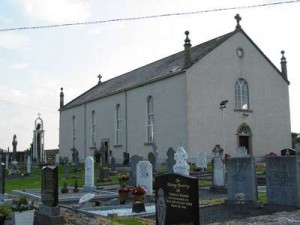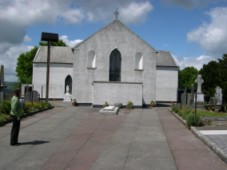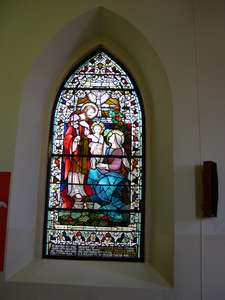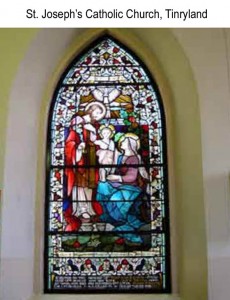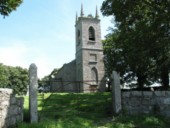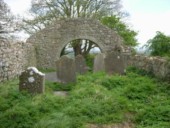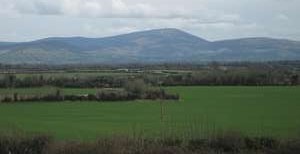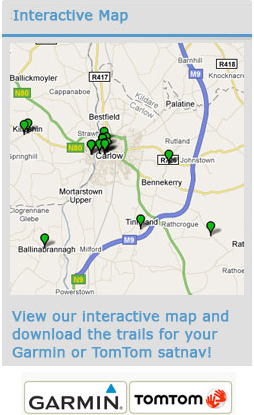Sites
Ballinabranagh – Baile na mBreatnach
The early nineteenth-century 13. St. Fintan’s Catholic Church is a fine example of a double-height single-cell ‘barn-style’ ![]() space lit by round-headed windows. The gables are adorned by squat columnar granite pinnacles. The fanlit entrance doorway, set in a granite architrave, echoes the contemporary taste in domestic architecture. Features of note include the marble altar which was presented to the church by Cardinal Moran (see Ballinkillin entry on St. Laserian’s Trail).
space lit by round-headed windows. The gables are adorned by squat columnar granite pinnacles. The fanlit entrance doorway, set in a granite architrave, echoes the contemporary taste in domestic architecture. Features of note include the marble altar which was presented to the church by Cardinal Moran (see Ballinkillin entry on St. Laserian’s Trail).
The interior was re-ordered in 1983 when the porch and the choir gallery were removed. A new granite altar and unusual baptismal font were installed.
To the left of the church, in the car park, can be seen the tiny schoolhouse where John Conwill, a local teacher, taught John Tyndall between 1836 and 1838. Tyndall was an internationally famous scientist whose work in the 1860s on the absorption and emissions of gases and vapours opened up the debate on the greenhouse effect. He is best remembered for his 1850s invention, the Light Pipe, the basis of Fibre Optics. He stayed in regular contact with his former teacher until Conwill’s death. Other famous figures taught by Conwill include Cardinal Patrick Moran and the brothers Patrick and John Foley who became respectively Bishop of Kildare and Leighlin and President of Carlow College.
Admission: Free
Parking :Yes
St. Fintan’s Catholic Church
St. Fintan’s Catholic Church
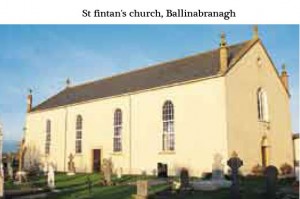 The early nineteenth-century St. Fintan’s Catholic Church is a fine example of a spacious ‘barn- style’ building. Features of note include the marble altar which was presented to the church by Cardinal Moran (see page 31).
The early nineteenth-century St. Fintan’s Catholic Church is a fine example of a spacious ‘barn- style’ building. Features of note include the marble altar which was presented to the church by Cardinal Moran (see page 31).Tinryland – Tigh an Raoilinn
14. St. Joseph’s Catholic Church was originally built in 1819 by Fr. Matthew Malone and consecrated by James Doyle, then Bishop-Elect of the diocese of Kildare and Leighlin. It was built on the site of a mud-walled chapel. The three stone fonts in the porch came from this chapel while an old font from Linkardstown Church can be seen at the front of the church.
The interior contains the striking stained glass window to the memory of Captain Myles Keogh who was born in Leighlinbridge in 1840 and was killed at the battle of the Little Big Horn in 1876.
Keogh was born in Orchard House, Leighlinbridge in 1840 and was educated locally. At the age of 18 he may have been fighting with the French Foreign legion in Africa but at 20 he volunteered to fight with the papal forces in Italy and became a member of the Vatican guard. From there he went to America in the 1860s to fight with the Union side in the Civil War. He had achieved the rank of Company Captain when he fell with General Custer in the famous battle of the Little Big Horn. The Sioux Chief, Red Horse apparently remarked that Keogh was the bravest man they ever fought.
Opposite the Keogh window, another stained glass window depicts the baptism of Christ. This window, which dates to 1936, was designed by A.E. Child, a prominent stained glass artist attached to the group An Túr Gloine (The Tower of Glass).
DID YOU KNOW
St. Joseph’s claims to be the first rural church in Ireland to use electric light due to local man Mr. Paddy Dowling, who played an important part in bringing electricity to rural Ireland in the 1940s.
 Open: Daily, 9.30 a.m. – 5 p.m.
Open: Daily, 9.30 a.m. – 5 p.m.
Admission: Free
Parking: Yes
St. Joseph’s Catholic Church
14. St. Joseph’s Catholic Church, built in 1819, contains the striking stained glass window to the memory of Captain Myles Keogh who was born in Leighlinbridge in 1840 and was killed at the battle of the Little Big Horn in 1876.
Keogh went to America in the 1860s to fight with the Union side in the Civil War. He had been promoted to the rank of Company Captain when he fell with General Custer in the famous battle. The Sioux Chief, Red Horse apparently remarked that Keogh was the bravest man they ever fought.
DID YOU KNOW
St. Joseph’s claims to be the first rural church in Ireland to use electric light due to local man Mr. Paddy Dowling, who played an important part in bringing electricity to rural Ireland in the 1940s.
Admission: Free
Parking: Yes
Kellistown – Cill Asna – St. Osnadh’s church
Ruined nineteenth-century 15. Church of Ireland church with remains of medieval church behind. Situated on an elevated site overlooking rich rural countryside, this ruinous First Fruits church![]() dates from 1810. It has an austere simplicity and comprises a three-bay nave
dates from 1810. It has an austere simplicity and comprises a three-bay nave![]() with lime rendered walls and pointed windows, a porch on the north side and a three-stage, west tower with crennelations
with lime rendered walls and pointed windows, a porch on the north side and a three-stage, west tower with crennelations![]() and pinnacles. The earliest church to occupy the site was a monastery associated with St. Osnadh and a round tower survived here until the nineteenth century, when it was removed during the building of the Church of Ireland church.
and pinnacles. The earliest church to occupy the site was a monastery associated with St. Osnadh and a round tower survived here until the nineteenth century, when it was removed during the building of the Church of Ireland church.
The site has strong associations with St. Patrick and the medieval church - whose remains can be seen behind the nineteenth-century church – was dedicated to him. The remains reveal a large rectangular structure built from granite boulders. There is a small piscina and a large fragment of a finely dressed polygonal font can also be seen.
In the thirteenth century Kellistown was settled by the Anglo-Normans and the church was given to the Augustinian Priory of Kells, Co. Kilkenny. The present remains probably date from this period.
Kellistown was the site of several famous battles including one in 1398 when Roger Mortimer, Royal Lieutenant of Ireland was killed while doing battle with the O’Byrnes and other Gaelic chiefs.
Admission: Free
Parking: Yes
![]() First Fruits Church: A Church of Ireland church whose building was financed by the Board of First Fruits established largely through the influence of Jonathan Swift (1667 – 1745).
First Fruits Church: A Church of Ireland church whose building was financed by the Board of First Fruits established largely through the influence of Jonathan Swift (1667 – 1745).
![]() Nave: The main aisle of a church, occupied by the congregation.
Nave: The main aisle of a church, occupied by the congregation.
![]() Crennelation: Notched parapets, resembling those on a stone castle.
Crennelation: Notched parapets, resembling those on a stone castle.
